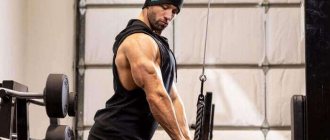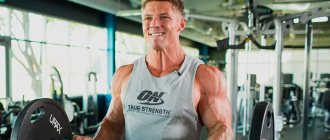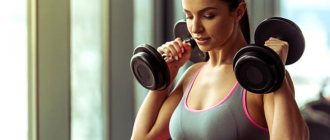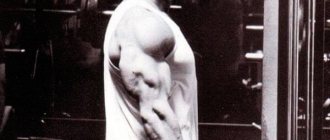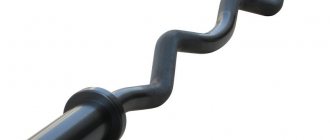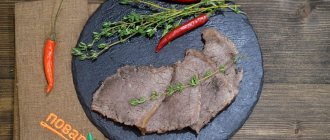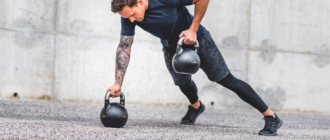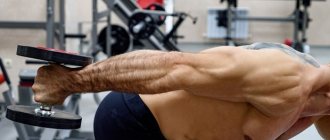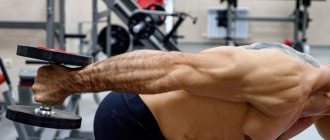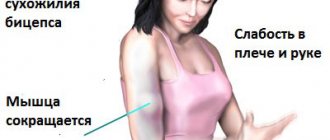The arm muscles consist of the muscles of the shoulder (upper arm), forearm and hand. The shoulder is formed by one bone - the humerus, and the forearm by two - the radius (located on the side of the thumb) and the ulna (located on the side of the little finger). The elbow joint is a trochlear joint and connects the humerus, radius and ulna. It allows flexion and extension of the arm, as well as rotation of the forearm. In addition, thanks to the muscles of the forearm, we can rotate the hand. The wrist joint is located between the forearm and hand.
SHOULDER MUSCLES
The shoulder of muscular people has the appearance of a roll, flattened on the sides. The musculature of the shoulder consists of muscles located parallel to the vertical axis of the shoulder. On the front surface of the shoulder are strong forearm flexors. The skin in this area is thin, so the outlines of the muscles are clearly visible, especially when the biceps muscle contracts, which then takes on the shape of a hemisphere. It is widely believed that the larger and more convex this hemisphere, the stronger the person.
BICEPS
The biceps, or biceps brachii muscle, consists of two heads. The long head begins from the supraglenoid tubercle, and the short one from the coracoid process of the scapula. Both heads are located along the humerus. Just below the elbow they are attached to the inside of the radius. The main function of the biceps is to flex the arm at the elbow joint, as well as participate in supination of the forearm, when the palm facing down turns up. The relief of the biceps is best seen when the forearm is flexed when it is in a supinated position.
In addition to the biceps, two more muscles are responsible for bending the arm at the elbow - the brachialis and brachioradialis.
BRACHIAL MUSCLE
The brachialis muscle is located under the biceps. It can only be seen under the inner edge of the biceps. The outer edge is visible only at the insertion of the deltoid muscle in the area of the lower half of the humerus. The development of the brachialis muscle also affects the steep outline of the biceps muscle. The brachialis muscle starts from the lower half of the anterior surface of the humerus and attaches to the tuberosity of the ulna. Thus, the brachialis muscle raises the ulna, participating only in flexion of the forearm.
BRAIRADIAL MUSCLE
The brachioradialis muscle starts from the humerus, runs along the entire forearm and is attached to the radius in the area of the wrist joint. The main function of the brachioradialis muscle is to flex the arm at the elbow joint. When flexing the forearm, especially if this movement occurs while overcoming any resistance, the brachioradialis muscle clearly protrudes in the form of a sharp ridge in the area of the cubital fossa.
TRICEPS
On the back of the shoulder, the triceps brachii muscle stands out - Triceps or triceps brachii muscle. As the name of the muscle itself indicates, it has three heads. The long head starts from the subarticular tubercle of the scapula, the medial (inner) and lateral (lateral) heads start from the humerus. All three heads converge into one tendon, which attaches to the olecranon process of the ulna. All three heads of the triceps cover the elbow joint, and its long head also covers the shoulder joint. The main function of the triceps is to extend the arm at the elbow joint. The muscle is visible when trying to straighten the arm at the elbow joint, performed with resistance: then the outer and long heads in the upper half of the shoulder become noticeable, which form a characteristic fork.
Triceps anatomy
The triceps brachii, as its name suggests, consists of three heads. The long head originates from the infraglenoid tubercle of the scapula, and the short heads (lateral and medial) originate from the proximal humerus. These three heads connect directly at the level of the olecranon and form one of the most powerful tendons in the human body. This muscle covers the entire back of the shoulder and tears are quite rare.
Triceps brachii ruptures usually occur at the level of its attachment to the olecranon process, that is, they are essentially avulsions, and often include a small fragment of bone. The triceps brachii attaches to the olecranon process over a large area. On average, the triceps attachment area is about 4.5 cm² and has a width of 2 to 4 cm and is shaped like a triangle, with the base located distally and the apex proximally. On the lateral side, the triceps tendon connects to the m.anconeus fascia.
Symptoms
Patients with this condition usually experience pain in the back of the elbow. In less severe cases, patients may experience only pain and stiffness in the elbow, with symptoms worsening when performing movements that require strong or repetitive contraction of the triceps muscle. These are activities such as doing push-ups, bench presses, falls, boxing punches, and hammer work.
In more severe cases, patients may experience pain that increases to acute pain when performing various activities. Sometimes patients notice swelling in the back of the elbow and experience weakness when trying to straighten the elbow against resistance and pain or discomfort when performing movements associated with contracting the biceps. The pain may also increase when the damaged tendon comes into contact with hard objects.
Etiology of triceps avulsions.
Triceps avulsions occur due to overload during extension or sudden sharp concentric contraction. The most common mechanism of injury is a fall on an almost fully extended arm. It is also possible for a tendon to rupture when performing French presses and other triceps exercises for bodybuilders.
Also, predisposing factors are prolonged functional overload that exceeds regenerative capabilities, bursitis in the olecranon area, rheumatoid arthritis, systemic lupus erythematosus, as well as long-term use of steroid drugs.
Basic rules
Please note right away that you don’t need to focus only on biceps or triceps - you need to develop the muscles as a whole. That is, to get beautiful hands, you should pay attention to the muscles of the back, neck, shoulders, abs and even legs. The body looks much more beautiful if the muscle groups are pumped evenly.
Always warm up your body before exercising to avoid serious injury. As for the classes themselves, they do not have to be carried out every day - 3-4 times a week is enough. If you try too hard, your biceps and triceps simply won’t recover. All you get is overtraining.
The main goal when performing biceps and triceps exercises is to do the maximum number of repetitions. The result should be maximum wear and tear until a slight burning sensation appears inside the muscle being worked. The number of total repetitions is from 8 to 14. The total duration of the approach should not exceed one minute. At the same time, you should not do more than 3 different exercises to work the biceps muscle (this is pointless). The best option is to choose 5-6 different exercises and alternate them from workout to workout.
Biceps develop best in splits, when the muscles are conditionally divided into groups and pumped separately from each other. At the same time, the work must be done efficiently, in compliance with all the rules of bodybuilding.
Ideal sleep is 8 hours a day. This time is enough for the body to fully recover and be ready to take on new loads. The same can be said about diet. It should contain protein, carbohydrates and even some healthy fats.
Diagnosis of triceps brachii avulsions.
Most often, the tendon of the long head of the triceps, which is attached to the olecranon process on a broad base, is torn off. In this case, active extension in the elbow joint is maintained in 80% of cases, but there is a significant decrease in the extension force to 1/5 of the contralateral side. Due to the preserved extension function, the frequency of false-negative diagnoses is high.
During palpation, you can often feel the tendon stump located subcutaneously 2 cm proximal to the olecranon process; palpation in the area of the process itself is sharply painful. You can also perform an analogue of the Thompson test for the Achilles tendon, but for this you need to place the patient on the couch so that the shoulder lies on it perpendicular to the axis of the body and the forearm hangs freely and relaxed.
When taking x-rays, you can sometimes see a small bone fragment avulsed from the olecranon.
You should not count on this sign when making a diagnosis. But its presence should be interpreted as a triceps avulsion and an MRI should be done to exclude it.
After instrumental confirmation of the diagnosis, it is necessary to make a decision on further treatment tactics. In case of acute triceps avulsion, even with partial damage, surgical treatment and refixation of the tendon to the olecranon process are preferable. For old injuries, more than 6 weeks old, the option of conservative treatment using a functional method can be considered, since surgical treatment by this point becomes much more traumatic and less effective. The release of tendon from scar tissue and the often required performance of tendon grafting is accompanied by long-term rehabilitation, a high risk of the formation of heterotopic ossification and joint contracture, for this reason the selection of candidates for such an operation should be more careful. For complete triceps avulsions, surgical treatment is preferable in all cases, since the function of the limb is significantly affected by these injuries.
Best exercises
To effectively and quickly pump up your triceps and biceps, you need to choose the right exercises. In the case of the biceps brachii muscle, give preference to the following training options:
- curling arms with dumbbells. In this case, take the shells with a reverse grip and alternately bring them to your shoulders;
- barbell curl. Here the principle of performing the exercise is the same with the only difference that instead of the main apparatus there is a barbell;
- pull-up on the bar. To put more stress on your biceps, grab the bar with a reverse grip. In this case, your hands should be placed slightly narrower than shoulder width. If the exercise is too easy to do, then you can use a weight that is fixed in front of the belt. As you pull up, tuck your chin over the bar;
- close grip bench press. Everything here is the same as with a regular bench press. The only thing is that your hands are shoulder-width apart.
Surgical treatment of triceps brachii avulsions.
There are several techniques for refixing the triceps to the olecranon.
Initially, the transosseous suture technique was used, with either a transverse tunnel or X-shaped tunnels being made in the olecranon. After suturing the distal part of the tendon according to Krakow, the threads are passed through these tunnels and tightened on the opposite side.
Recently, anchor or anchor clamps have become more widely used. They avoid the need to make through tunnels in the olecranon process, and also allow you to increase the area of pressure of the tendon to its native attachment site when using several (3-4) anchors. Currently, anchors with low-profile tapes have appeared and are becoming increasingly widespread, as well as knotless anchors for performing a double-row seam, which allow achieving the maximum possible area and fixation power while using a minimum amount of suture material. Unfortunately, these implants have a higher price and are technically a little more difficult to install. (Yeh PC, Stephens KT, Solovyova O, et al. The distal triceps tendon footprint and a biomechanical analysis of 3 repair techniques. Am J Sports Med 2010;38:1025-33.)
Author's preferred method.
For the earliest and fastest possible rehabilitation and also to reduce the risk of postoperative complications, in our opinion, it is preferable to use the double-row suture technique using 3 or 4 anchors. In our practice, we use retainers from Arthrex.
Access to the projection of the olecranon and distal triceps tendon.
When performing access in this case, attention was drawn to fibrous-changed tissues of the subcutaneous bursa of the olecranon, indicating previous bursitis and long-term chronic inflammation. A complete separation of the tendon of the long head of the triceps brachii from the olecranon process with a small bone fragment is determined.
The area of attachment of the triceps to the olecranon is refreshed using a rasp, and the first row of anchors is installed in the olecranon.
The triceps tendon is stitched with 2 Krakow sutures with 3 tiers of loops along the periphery and 2 adaptation U-shaped seams.
After tightening the threads, the tendon is already securely fixed to the olecranon process. To increase the area of its contact, the ends of the threads from the U-shaped sutures are tied together, and the ends of the Krakow sutures are threaded into a knotless anchor, which is installed on the more distal part of the ulna in the direction of the coronoid process, pressing the tendon stump to the olecranon process.
In the photo above you can see the final appearance of the repaired triceps tendon and a schematic indication of the location of the anchors and sutures that press the distal end of the tendon to its native insertion on the olecranon.
Why pump your arms at all?
First, let's figure out why you should pay attention to your hands and train these muscle groups. There are several points here:
- women love guys with strong arms. This creates the image of a reliable protector who can protect you from adversity;
- beautiful biceps and well-pumped triceps look great in the summer, for example, in a T-shirt or short-sleeve T-shirt. It is from the muscles of the arm that one can see that their owner is in excellent physical shape;
- if you are asked to demonstrate the result of work in the gym, then the biceps are shown first;
- by the appearance of the hands, as a rule, a conclusion is drawn whether a person is “hilyak” or not;
- worked triceps and biceps - an opportunity to achieve better results in working out other muscle groups. Strong arms allow you to work with heavy weights and, accordingly, results in the form of muscle growth are achieved faster;
- strong hands are a big plus for the weaker sex, because you can easily carry bags and other heavy objects (when there are no men nearby);
- beautiful and toned triceps - an opportunity to forget about the ugly appearance of your arms and the presence of “sagging”.
Rehabilitation after surgical treatment of triceps brachii avulsion.
After triceps refixation, a short period of rehabilitation is required to allow the skin wound to heal. If the double-row suture technique is used, then after removing the postoperative sutures 2 weeks after surgery, you can begin to gradually develop a passive range of motion. Full amplitude is restored by the end of 6 weeks after the intervention. From 6 to 12 weeks, physical therapy is carried out aimed at increasing triceps strength. Contact sports are allowed 5 months after surgery.
Causes
The most common cause of triceps tendinitis is repetitive, excessive stress on the tendon. This is typically associated with certain movements that require forceful extension of the elbow (such as push-ups or falls). Sometimes tendon damage occurs due to a critical, extreme load on the tendon. Most often, such loads occur during weightlifting or training on exercise machines. There are several main factors that increase the risk of developing tendinitis:
- joint stiffness (especially the elbow)
- muscle tightening (especially triceps)
- improper or excessive exercise
- insufficient warm-up before classes
- muscle weakness
- insufficient recovery period between workouts
- inadequate rehabilitation after an elbow injury
- a history of neck or upper back injury.
Forecast
Most patients with this disease recover with adequate treatment and can return to normal activities within a few weeks. But sometimes rehabilitation can take several months, especially for those patients who did not immediately seek medical help. Timely treatment (physiotherapy, exercise therapy) is a fundamental condition for a quick recovery. Lack of adequate treatment can lead to irreversible changes in the tendon tissue.
